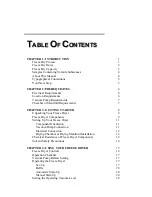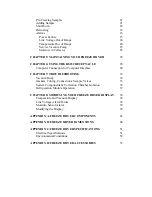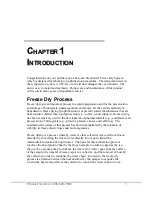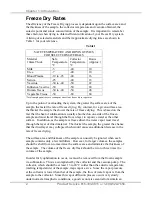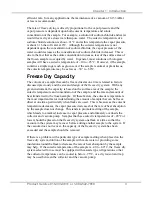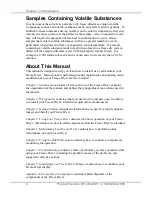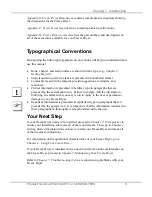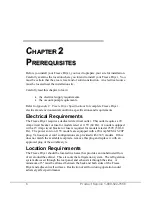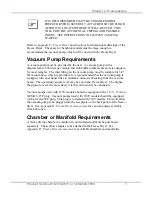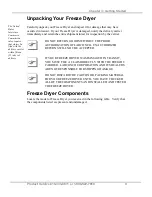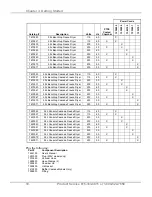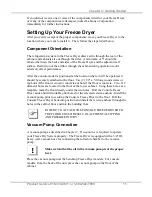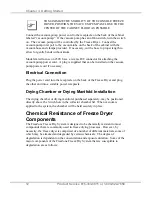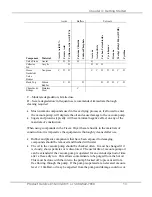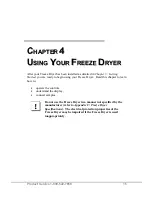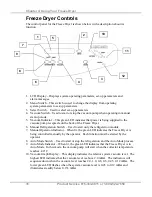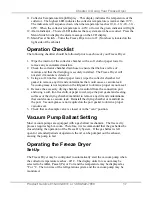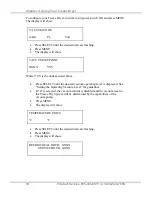
Chapter 1: Introduction
Product Service 816-333-8811 or 1-800-522-7658
3
efficient rate. In many applications, the maintenance of a vacuum of 0.133 mBar
or less is recommended.
The rate of freeze drying is directly proportional to the vapor pressure and the
vapor pressure is dependent upon both eutectic temperature and solute
concentration of the sample. For example, a solution of sodium chloride and water
would freeze dry at a slower rate than pure water. The eutectic temperature of a
sodium chloride solution is about –21°C and at this temperature the vapor pressure
is about 1/16 that of water at 0°C. Although the eutectic temperature is not
dependent upon the concentration of sodium chloride, the vapor pressure of the
water would decrease as the concentration of sodium chloride increased. This is
due to the fact that as the solute concentration increases, less of the surface area of
the frozen sample is occupied by water. In general, most solutions or biological
samples will have a eutectic temperature of –10 to –25°C. However, if the sample
contains a simple sugar such as glucose or if the sample is animal or plant tissue,
the eutectic temperature may be as low as –30° to –50°C.
Freeze Dry Capacity
The volume of a sample that can be freeze dried at one time is related to factors
discussed previously and the size and design of the freeze dry system. With any
given instrument, the capacity is based on the surface area of the sample; the
eutectic temperature and concentration of the sample; and the rate and amount of
heat transferred to the frozen sample. Of these factors, the eutectic temperature is
the most important factor in determining the amount of sample that can be freeze
dried at one time, particularly when flasks are used. This is because as the eutectic
temperature decreases, the vapor pressure decreases but the rate of heat absorption
by the sample does not change. This tends to promote melting of the sample,
which leads to a marked increase in vapor pressure and ultimately overloads the
collector and vacuum pump. Samples that have eutectic temperatures of –20°C or
lower should be placed on the freeze dry system one flask at a time so that the
vacuum in the system may recover before adding another sample to the system. If
the vacuum does not recover, the capacity of the freeze dry system has been
exceeded and the sample should be removed.
If there is a problem with a particular type of sample melting when placed on the
freeze dry system, dilution of the sample with more water or providing some
insulation around the flask to decrease the rate of heat absorption by the sample
may help. If the eutectic temperature of the sample is –40 to –60°C, the freeze dry
system selected for use must be equipped with cascade type refrigeration so that
the collector temperature can be cooled to below –75°C, or a dry ice/solvent trap
may be used between the collector and the vacuum pump.
Summary of Contents for FreeZone 74200 Series
Page 5: ......
Page 53: ...Product Service 1 800 522 7658 48 APPENDIX B FREEZE DRYER DIMENSIONS Model 76705xx ...
Page 62: ...Appendix D Freeze Dryer Accessories Product Service 816 333 8811 or 1 800 522 7658 57 ...
Page 63: ...Appendix D Freeze Dryer Accessories Product Service 816 333 8811 or 1 800 522 7658 58 ...
Page 64: ...Appendix D Freeze Dryer Accessories Product Service 816 333 8811 or 1 800 522 7658 59 ...
Page 65: ...Appendix D Freeze Dryer Accessories Product Service 816 333 8811 or 1 800 522 7658 60 Ampules ...



